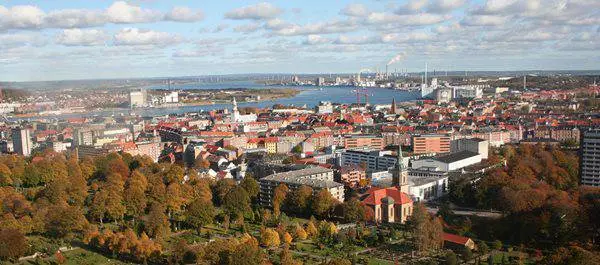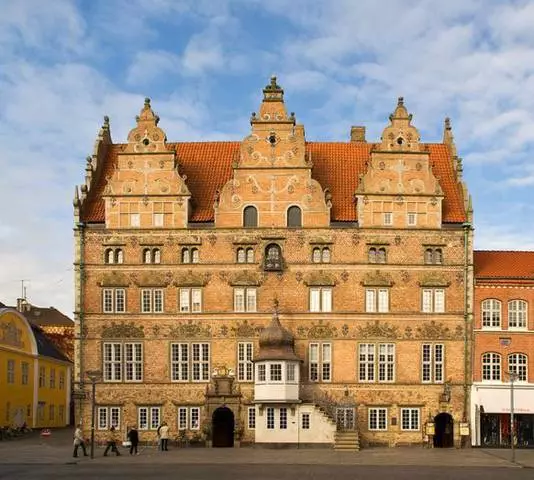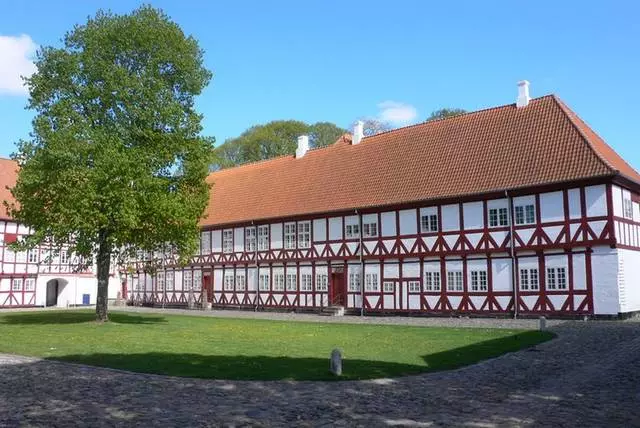Aalborg is a charming town with Renaissance style, with a gothic style cat and a half-timbered lock.
A characteristic city landmark in Aalborg is Yomfru Anna, consisting of fully from restaurants and bars with spacious rooms and small, outgoing terraces.

More notable places in this fourth largest Danish settlement are concentrated in the old town.
On the coast of Fjord Limbfjord, many times have existed settlements, the first of which are dating about 700 to our era approximately 700th. An undoubted fact is that Olborg was in this place already in the 1040th year, he was only called then differently - Alabu (Alabu) - it means in the Danish "City of the Creek". This settlement was rather rich - because of its strategic location, here the trading people built their houses from stone, as well as warehouses. The city was entitled to hold fairs in the 1342nd year, and at the time when he was given the right of monopolian trade of herding - in 1516, Olborg on financial well-being could give odds to all Copenhagen's cities - the closest competitor was only Copenhagen. And in 1554 it was formed by the Diocese - the center was in Aalborg - she happily lived to the present day. The city was almost not affected by the military conflicts of the sixteenth-seventeenth centuries, however, in the second world it was quite quickly occupied by the fascists. The landing seizure of Aalborg was the first for the entire world history (the remaining territories of the mainland Denmark Germans won, moving around the country with bicycles).
Old city
The two most notable towns located in the area are the Cathedral of St. Budoli, built in the fourteenth century, and the home of the Jens Banga merchant.
Saint Budoli Cathedral
The Romanesque Church, consecrated to the glory of the English Saint, Defender of Sailors - St. Budoli, built in this place in the tenth century, but it was destroyed in fourteenth. Then a new temple was built on the old foundation. In 1779, the building acquired a baroque spire, which was built with the help of funds that Jackob and Elizabeth Himmering. The temple was rebuilt under Haka Capfmann (Hack Kampmann, see Aarhus) - in the 1899-1900s, as well as in 1943 (Eino Packness). The gothic frescoes of the sixteenth century, in the lobby and in the temple itself - the altar built in the lobby and in the temple itself - the altar, built in the 1689th year and decorated with patterned coat of arms, a font to the baptism rite, dated 1728th, the Department of 1692, and a whole gallery of images Renaissance era. It is worth noting such a feature - all the values of the internal decoration presented the churches of wealthy traders.
House of the merchant Yens Bang
Jens Bang had the glory of one of the most secured citizens. In 1624, he decided to prove it to everyone and erected a huge brick mansion in the style of Renaissance. Now this building is known as the greatest Renaissance building of Northern Europe.
Jens Bang was a man who did not devoid of the sense of humor - in this you can make sure the image of a person who dried the tongue was cut on the wall of his house; The wall, in turn, is just against another architectural note - the city hall. According to legend, the merchant sought to be elected in the city council, however, despite his financial well-being, he could do this and failed. So he is thus "revenged". Nowadays, the pharmacy is located here - the oldest in Aalborg. And there is also another curious construction of the same architecture - the house of Gaorden Alfssen. He is not so interesting, however, only because his owner was in kindred relations with Jens Bang, the desire to compare these two buildings.

Castle Olborghuz
A very interesting building of civil architecture is the castle of Olborghuz. Hold it in the sixteenth century. This merit belongs to the King Christian to the third - at first, the castle performed a protective function, and later turned into a government residence. There is no access to the Castle itself, however, it is possible to go through the territory near him - throughout the year, from 08:00 to 21:00. Entrance to the caasemates and donjon - only in the May-October period. Donjon happens open all days, excluding Saturday and Sunday - from 08:00 to 15:00. Casemates work on daily schedule - from 08:00 to 21:00.

Museums in Olborg
As for museums, in Aalborg, it is worth noting the city historical museum, where you will be able to learn about the history of the settlement for the last thousand years. On Tuesday, entrance to the museum is free.
And such an institution, as the Museum of Art of Northern Jutland, can be attributed to the best attractions in Aalborg, not located in the Old Town. The main exhibits are dated to the end of the nineteenth - twentieth centuries. This cultural institution works on Tuesday-Sunday schedule, open from 10:00 to 17:00, on Mondays - the day off. At autumn, as well as in February-April on Tuesdays, the museum continues to work until 21:00. For the entrance it will be necessary to pay 60 Danish crowns, children under eighteen do not pay for a visit.
Among the best cultural institutions are also the Museum of Navy. It works on the following schedule: from January 1st to April 30 - open from 10:00 to 16:00, from May 1 to September 30 - from 10:00 to 17:00, with 1- October until December 31st - from 10:00 to 16:00. For the entry, pay 80 Danish kroons, children from six to fourteen years pay 40 kroons. Those who are younger - the entrance is free.
Aalborgcard has an action in Aalborg - if you acquire it, you will get free access to thirteen local attractions as bonuses - including museums, free public transport (including buses and trains), as well as large discounts When servicing in cafes, restaurants, on shopping, rental vehicles, it is possible to park for free in the central part of the city. The duration of the card is two types - for a day and for three days.
